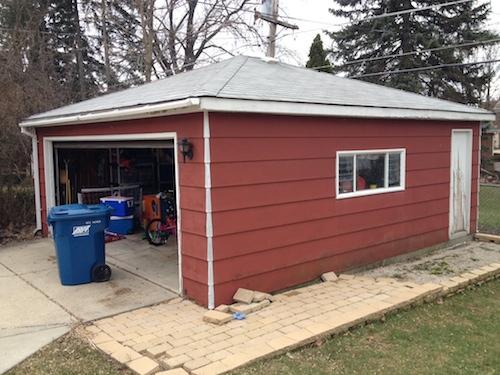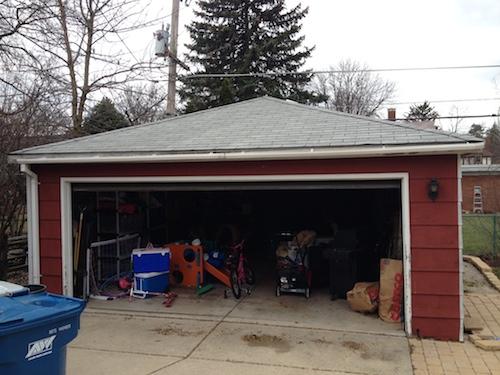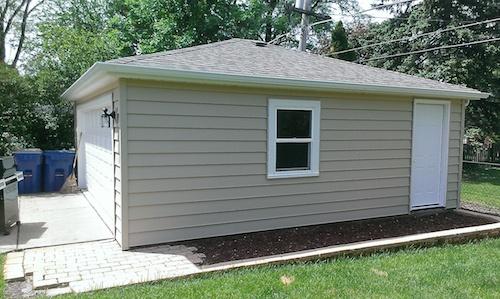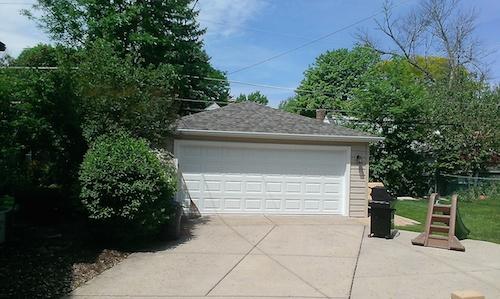Recent Blog Posts
Garage Project Blog - LaGrange Park, IL
In addition to building brand new custom garages, Blue Sky Builders, Inc. also does garage repairs and remodels! So, for this project blog, we'd like to share with you a recent garage remodel we completed in LaGrange Park, Illinois.
The existing garage was structurally sound but in bad shape cosmetically (pictures below). The owner did not want to go with a brand new garage, so opted for a remodeling, as it was the most economical solution.
Garage Before Pictures


Garage Remodel Details
Garage Style: Hip
New Door: 16×6'6″
New Siding: Certainteed 7″ vinyl siding
New Window: Vinyl
New Roof: Certainteed architectural shingles
New aluminum soffit/fascia/trim, gutters
Garage Remodel After Pictures

Garage vs Carport: Pros and Cons
Vehicles and similar assets such as boats, motor cycles, ATVs, etc., represent large investments that homeowners want to protect against harm from outside elements. Which is one good reason to plan a new garage or carport project.
But which is right for you and your family? We will outline the pros and cons of a garage vs a carport below.
Carport Pros
- Less expensive - Building a carport is far less expensive than building a garage. Fewer materials are required since there are no walls, doors or windows, and that translates to lower labor costs, too.
- Quick to build - Carports are relatively simple structures, so they can be built very quickly. An experienced handyman could probably complete the job in just a couple weekends.
- Easier to get approval - Because carports are not considered enclosed or livable space, it's usually easy to get the project approved by your city or town. The guidelines are less stringent. For example, you won't be required to build fire-rated walls or ceilings.
3 Tips For Preventing Garage Fires
Every year there are about 6,600 garage fires at homes in the United States, resulting in an average of 30 deaths, 400 injuries, and more than $457 million in property loss. Of these fires 93% occurred in one- and two-family homes.
Here are some safety tips to avoid these destructive fires and limit their impact if they do occur.
Electricity
The leading cause of garage fires is electrical malfunction, which can be due to shorts in wires, damaged wires, and overloading electrical outlets. Plug only one charging appliance into an outlet. Do not use an extension cord when charging an appliance.
Flammable material
Store oils, gasoline, paints, propane, and varnishes in a shed away from the home or in a fire-rated cabinet.
Fireproofing
Make sure that the door between the house and garage is a 20-minute fire-rated door with a self-closing device and self latching. Make sure the garage walls are covered with 5/8-inch type K gypsum fire board and have a heat alarm installed in the garage, not a smoke detector. The heat detector will react faster to temperature changes. The heat detector needs to be rated for between 175 and 250 degrees Fahrenheit. Have the unit installed by a qualified electrician and never install heat detectors above or near fluorescent lights.
Wooden Garage Door Maintenance Tips
The first garage doors relied heavily upon wood to complete their construction. Today, wood still continues to appeal to those seeking traditional styles and materials. Wood doors are available in a variety of styles and can even include windows.
On the low-cost side of the spectrum, wood doors are available in painted, flat hardboard panels. On the other side, stain-grade wood doors cost more, but offer the warmth of natural wood that can make a big difference in the curb appeal of a house. Regardless of which side of the spectrum you may choose, all wood doors need to be maintained and refinished regularly. We will share some maintenance tips below.
Stain and Varnish
You should religiously be applying layers of wood stain and wood varnish to your wood garage doors. The wood stain will preserve the natural look of the garage doors, which may have been the reason you opted for them in the first place. The wood varnish will provide a more professional finish and also leave a protective layer over the surface of the wood
Father’s Day Guide to Turning a Garage Into a Man Cave
Give your dad the ultimate gift this Father's day – his very own man cave!
A garage man cave is less expensive than building a new addition onto your house and will take a lot less time, so it's a great option for extra space. And it will give dad plenty of space to do ‘man things'.
Below we will share a guide to transforming your garage into a man cave in 6 steps and pictures of some awesome garage man caves.
1. Planning
The first decision you need to make with your garage space is how extensive you want your conversion to be. If this space is going to be used all day and night as a living quarters, and you live in an area with weather that gets very cold or hot, you have a lot more things to do to convert the space (i.e. heating, air conditioning, insulation throughout). However, if you are doing something simpler, such as an area for manly socializing, you can get by with less work.
This decision is very personalized. When creating a primitive man cave, you can get by with very minimal if you think that's ok with your dad. Or if you prefer to make it look like a room inside a home, that's always an option it just requires a lot more work. If you plan on using any electronics, or if you're putting in a pool table, insulation and HVAC are a must to protect your toys from extreme temperatures and humidity.
Safety Tips For National Garage Door Safety Month
More than 70% of homeowners enter and exit their home through the garage door, relying on it as the new front door. And warm weather brings even more traffic in the garage.
Since it is now National Garage Door Safety month we thought we would share a "door to floor" garage door safety checklist. While garage door safety is important all year round, make this an opportunity to complete an inspection.
Maintenance
To keep the garage door properly maintained and functioning safely, be sure to keep all moving parts of the door clean and lubricated, including the steel rollers.
Balance
To check balance, start with the door closed and pull the opener release mechanism so you can maneuver the door by hand. If the door is balanced (properly spring-loaded and running freely on its tracks), you should be able to lift the door smoothly without much effort and it should stay open about three or four feet above the floor.
Safety Reverse
Since 1993, all automatic openers manufactured for the U.S. must include a safety reversing feature such as infrared sensors or "photo eyes." These sensors are installed near the floor on either side of the garage door opening. Once the invisible laser beam between the two sensors is broken by an obstruction, the door reverses automatically. If your opener lacks a similar safety reversing feature, it's time to get a new opener.
Get Your Garage Ready For Summer
We have experienced a seemingly endless Winter in the Chicagoland area this year. And finally, the weather is starting to warm up! With the first day of summer just around the corner - June 21st - we would like to share a few tips for getting your garage ready for summer.
Garage sales, barbecues, parties. Activity in the garage increases exponentially during the summer months. And as a result, it is important to prepare your garage in advance for the coming months.
Get your garage organized
Organizational needs change throughout seasons. Place items you will need for summer months in an easy to access place near the exit to the garage, while moving seasonal or cold-weather items into storage bins or onto shelves. For example, you may want to place a grill, toys, or a lawn mower close to the exit so it is easier for you to access.
Perform maintenance activities
With the weather warming up, it is the perfect time to complete those tasks you have been putting off all winter. Wash away seasonal grime on your garage door and windows to prevent rust. Apply a fresh coat of paint to your garage door. Or, consider insulating your garage for the summer. Insulated garage doors can help keep an unconditioned garage comfortable on a sizzling summer day as well as help manage temperatures in living spaces above the garage
Factors To Consider When Choosing a Garage Door Opener
When choosing the right garage door for your home, it is important to keep three things in mind when making your decision: quiet operation, power, and drive type.
Below we will outline a little more information about each of these garage door considerations.
1. Quiet Operation
Garages adjacent to bedrooms or living areas, a quiet garage door opener may be important. Look for garage door openers ones constructed with dependable, quiet operation in mind.
2. Power
Your garage door opener must be able to handle the height and weight of your new garage door. Most garage door openers have 1/2-HP (horsepower) motors capable of handling most residential garage doors.
3. Drive Type
Quiet operation depends mostly on the type of operating mechanism or drive that's used to open the garage door. Four types of drives are available: belt drives, direct drives, screw drives, and chain drives.
- Belt drives use a sturdy rubber-like belt (similar to a car's fan belt) to open and close garage doors.
3 Types of Garage Roofs To Choose From
Garages attached to homes often share the home's roof. When garages are detached from the home, the roofs come in a few major types that blend well with the home and with other buildings nearby. Aside from the aesthetic consideration, choose the type of garage roof based on how you will use it and what types of vehicles you want to get inside.
Gable
You know a gable roof from its distinctive triangle shape. These are very common on stand-alone garages. A gable roof is described by its pitch. If the slanted side of the roof rises 4 inches for every 1 foot it travels toward the center, then it is called a 4/12 pitch. Most garage roofs use shallow pitches of 3/12 or 4/12. These shallow pitches do not give a typical garage enough room overhead for a separate story, but they do offer storage space for many types of materials.
Here are two examples of Gable garages we have built in the Chicagoland area:


Hip
If you fold the triangular ends of a gable-roofed building toward the center of the building, you end up with a hip roof. These roofs are very popular on stand-alone garages because they diminish the roof line so it competes less with the house roof, or other roofs nearby. Typical pitches for hip roofs on garages are 3/12 through 6/12. Since you lose the gable end, the overhead storage space is cut down unless you use a 6/12 or greater pitch. Hip roofs are economical to construct because you can eliminate the gable-end wall extensions on each end of the building. Hip roofs are also more aerodynamic and are better suited to places with high winds.
Garage Door Panels: Add Style To Your Garage Door
Garages doors make up a significant portion of your home's exterior. Therefore, it is important that the style you choose complements the rest of your home's exterior. One way to add style or your own personal touch to a garage door are windows and window panels. How else can you add style to your garage door?
Panel design. There are four main standard panel designs to choose from that we will share below. Which will work best for your new garage door?
1. Flush Panels
Flush panels are flat, slightly textured panels. They can be used to complement the surrounding wall area without drawing too much attention to the door itself.
2. Long-Raised Panels
Long-raised panels give depth and distinction to the door, while adding to the home's overall appearance.


 424 Ogden Ave, Downers Grove, IL 60515
424 Ogden Ave, Downers Grove, IL 60515 630-852-8485
630-852-8485









